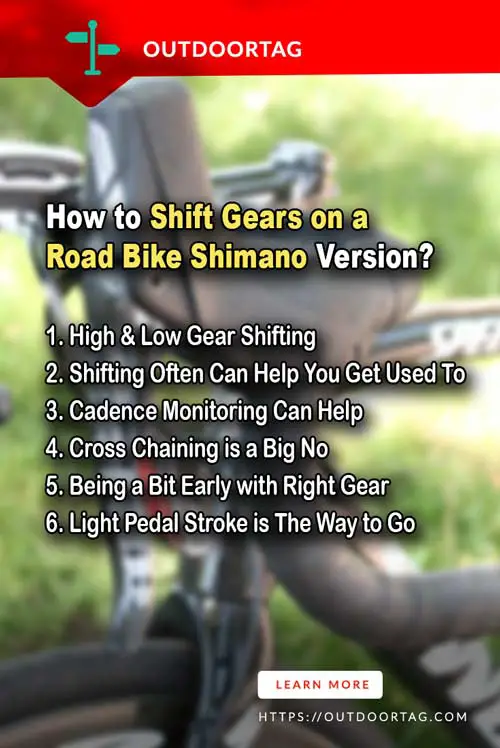From how many gears the bike you own has to the actual process of shifting gears, there’s a lot some may not know about at their starting stage. And it’s Okay! You still have time to grasp the basics and fundamentals of gear shifting. If you’re curious about these things lately, then there’s a good chance that starting from the basic terminology to actual shifting process is what you actually need to know about. And that is why today I’ll be providing a guide on how to shift gears on a road bike Shimano version.
Here’s How to Shift Gears on a Road Bike Shimano Version
From the most basic understandings of on-road biking to more complicating matters such as what gear to use when going uphill on a bike, we need to cover all. There’s no doubt both elementary and superior techniques are critical for those who ride road bikes. and that is why a comprehensive and in-detail guide is necessary at such points. Keep on Reading…
Get Familiar with The Terminology:
The whole shifting thing can seem very complicated unless you are well aware of the terminology. Some basic bike gearing lingo is what we’ll be talking about for a good start.
- The spot where the bottom bracket is connecting to pedals in front of your bike should have a certain number of gears. This figure is the chainrings.
- On the rear wheel, there should be a cassette collection that is known as cogs.
- In cassette cogs and front chainrings, there should be notches. The number of these notches are teeth.
- There are two derailleurs on road bikes. One in front of the chain movement from big chainring to small and vice versa. Another works for chain moving up and down on cassette.
- With high gear shifting, it will be hard to pedal. The opposite of this term is low gear, meaning pedaling will be easier.
- Multiply front chainrings and cassette cogs number to find out the number of gears of your bike.

High & Low Gear Shifting – Explained
There should be levers placed on front and rear brakes. These are going to help you with the higher and lower gear shifting of your bike.
With left shifting and brake lever movement inwards, you can make the chain go from a small chainring to a large one. And this is why pedaling becomes difficult with this. While riding with big chainring, try to move just the shifting level. This will make pedaling easier as the chain will go from large toward small.
To move the chain up and down in rear cassette, right shifting lever works. If you try to move both brake and shifting lever in Shimano style shifters, then chain will go up the cassette. It’ll enter to a larger cog. And this will make the pedaling easier. This is known as downshifting.
You can also move just the right shifting lever in. So that chain can move down the cassette. And this will go to a smaller cog. This way it will make pedaling harder. It’s known as upshifting.
Now you are well aware of the basic ideas. Practicing the technique will however still need some tips and rules to utilize. Let’s talk about those in the next few paras.
Shifting Often Can Help You Get Used To
The thing that is pretty common with beginner riders is keeping on with one gear for as long as they can rather than frequent shifting. However, it’s best to try different gear ratios. So that you can get comfortable with it.
Also, it will help in identifying the gear that works best for certain terrain. You will save energy and your leg won’t suffer from serious fatigue at the end of a day. If small changes are what you need, then sticking to the right shifting lever should work best. Whole for the bigger speed change needs, you can utilize left shifting lever. This will help with front chain right shifting.
Cadence Monitoring Can Help
Monitoring your cadence can really help you to know about what right hear you’re in. Once you know the cadence that feels most comfortable to ride, try to shift for maintaining it. Suppose zone 2 is what you’re planning to ride for a long time. Here 90 rpm is what feels the most comfortable to ride. In such a case, you must shift whenever the rpm starts to rise or dip below 90. Staying within your preferred training zone will help a lot.
Cross Chaining is a Big No
The chain being stretched at a certain angle can cause unwanted situations. For example, slipping or derailleur rubbing. It could be frame also instead of the derailleur. And the main culprit here could be a few gear combinations.
Using front big chainring as well as the cassette’s largest cog can result in cross chaining. This can also happen by using the front small chain right and cassette’s smallest cog. So, you must avoid such a gearing combination by all means. Or else avoiding damage to the bike and drivetrain will be quite impossible.
Being a Bit Early with Right Gear
If you wait for a pretty long time for shifting then there’s a good chance of killing mentum as well as slowing down. Don’t wait until you are on the climb for making a decision of shifting big chainring to small. It’s best to switch the small chainring just slightly before instead of that. It should be a little earlier to hit the bottom of climb. So that the shift can be easier. And this will also avoid gears grinding. You will also start climb without much speed loss this way.
Light Pedal Stroke is The Way to Go
When you are attempting shift, trying with too much torque on pedals can result in this situation of dropped chains. Small to big chainring shift decisions can be made a little bit later, as you speed slightly and lighten pedal stroke. This way you will decrease chain tension. And so there will be less pressure on the derailleur. Shift will feel much easier and at the same time, there will be pretty low chances of throwing chains.
Watch This!
Wrap Up
And that was all for our guide on how to shift gears on a road bike Shimano version. modern designs are easier to understand. But it’s best to have a good idea of basics to keep your rides stable and safe. Don’t forget to practice a lot and utilize the tips that were given today, Best of Luck!

